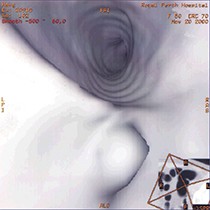Peer Reviewed
Gastroenterology clinic
An update on virtual colonoscopy (CT colonography)
Abstract
Virtual colonoscopy performed with computed tomography is a quick noninvasive technique of imaging the large bowel that should soon be more widely available in Australia.
Key Points
- Virtual colonoscopy (computed tomography colonography, or CTC) is a rapidly advancing technique that uses spiral CT to image the colon and rectum. In contrast to older generation CT scanning, which gave a series of axial slices, spiral CT obtains a ‘volume’ of information for interrogation.
- Two-dimensional cross-sectional images and computer software reconstructed three-dimensional ‘fly-through’ (virtual colonoscopy) images are obtained (Figures 1a and 1b). Image quality allows for the detection of elevated polyps, but not of finer mucosal detail such as vascular anomalies and colitis.
- Patients need to take bowel preparation as they would for conventional colonoscopy. The colon is distended with air by rectal catheter and CT imaging undertaken, during a single breath hold, in both prone and supine positions; this is to minimise false negative (that is, missed polyps) and false positive (for example, from faecaliths) findings. Sedation is not required.
- Sensitivity for detecting large polyps (1 cm and above diameter) in expert centres is similar to colonoscopy; the importance of this polyp size threshold relates to the significantly increased likelihood of current or future malignancy. Sensitivity for polyp detection decreases with decreasing polyp size.
Remember
Purchase the PDF version of this article
Already a subscriber? Login here.

